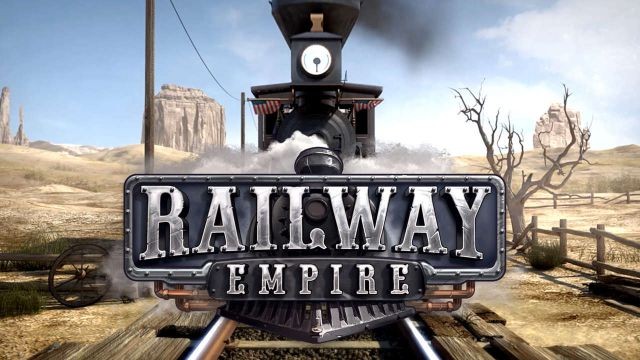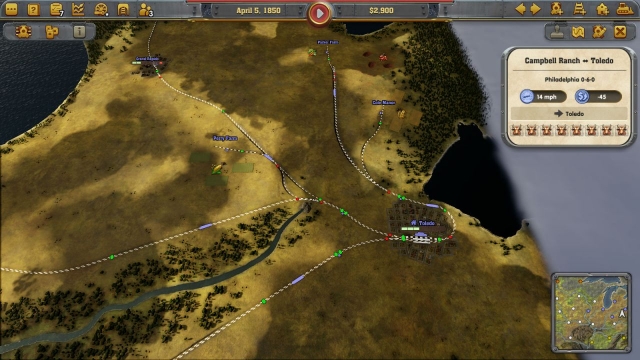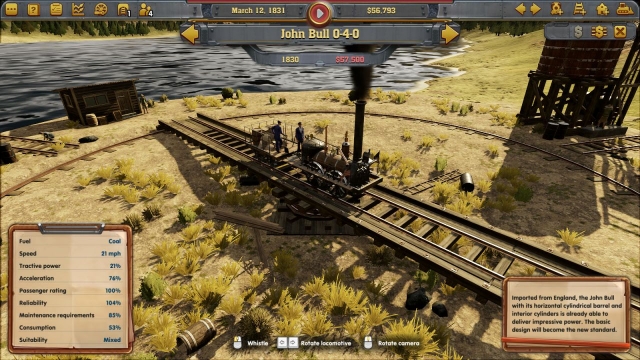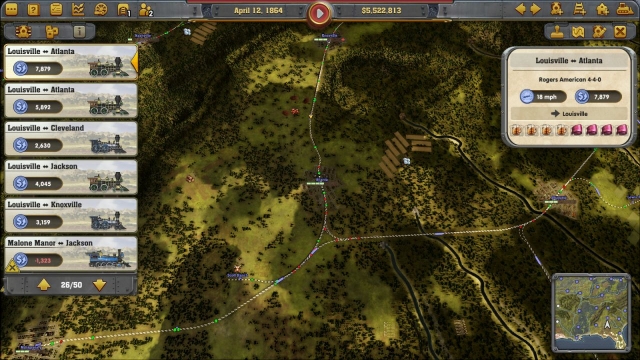Railway Empire

Railway Empire is a new railroading simulation from German developer Gaming Minds Studios. It covers roughly the same territory as the Railroad Tycoon games of old, where you’re tasked with laying track, purchasing locomotives, and delivering goods — all while turning a profit. Since the last Railroad Tycoon game came out over ten years ago, Railway Empire fills a much-needed niche.
When you start a scenario in Railway Empire, you have to choose some difficulty settings. These can include things like when you can pause the game (by default, it only pauses when you’re in construction mode) and what type of track you’re using (either “easy,” where trains can pass through each other, or “realistic,” where they can’t). You also have to choose a business avatar. These avatars grant you a small bonus to certain parts of the game. For example, the industrialist gives you better profits when delivering freight, while the engineer allows you to research new upgrades more quickly.
Then when you enter a scenario, you have to get to work building your empire. You always start with a train station in one of the cities on the map. From there you have to build more stations and then connect them with tracks. Nicely, laying track is pretty easy. It works about the same as drawing lines in a graphics program. You choose a beginning point (usually at a station), and then you choose points along the route that you want your trains to take, and the game fills in the tracks between them. You can also just select the beginning and ending points, and let the game construct a route for you, but the game doesn’t have any issue with tunnels or bridges (which are expensive), and so it’s better to plan the route manually.
About the only downside to laying track is that the interface doesn’t include any sort of “undo” button, and you can’t plan out more than one line of track before making the purchase. So if you want parallel tracks with switches between them, then you have to purchase one line of track, then the second line of track, and then the switches — and if you figure out during this process that your route isn’t working, then all you can do is bulldoze what you have (which recoups none of your investment) and start over. Or, more likely, you resort to a lot of saving and loading.
Once you have your stations and track set up, then you can add some trains. This is mostly easy, too. All you have to do is buy a train and then pick out the stations (or waypoints) for its route. By default, all trains are “automatic” for what they transport, which means they automatically pick up the goods that are worth the most at their next stop. You can also set up trains to deliver only freight, or to deliver only passengers and mail, or to prioritize certain goods, or to use a manual setup where you pick out exactly which goods they haul. Sort of oddly, the latter option is almost worthless because you have to choose one set of goods for the train’s entire route. You can’t change what it’s transporting to each city. But luckily, automatic trains are pretty effective, and it’s rare to need one of the other options.
Along with picking routes for trains, you can also hire personnel to run them. Your train crew can include a conductor (who increases mail profits or passenger profits), an engineer (who increases train speed or decreases maintenance needs), a stoker (who increases train speed or train reliability), and a security agent (who foils robbery attempts and increases freight profits). Unfortunately, job applicants only dribble in slowly, and the interface doesn’t give you an easy way to check which trains are missing personnel. I ended up mostly just skipping this aspect of the game, and running my trains without bonuses.
While you’re busy moving goods and growing your empire, you also need to conduct research. But oddly, instead of hiring scientists or funneling money into research projects, you just magically earn 40 research points each month to spend on new inventions, including more powerful train engines, train bonuses, and increased profits. If you use the engineer as your avatar, then you earn +8 points each month, and every time you build a university in a city, you earn +4 points. These bonuses are thoroughly useful, especially the engine upgrades during the early time periods, but still, this point system is a strange way to handle research.
The campaign that comes with Railway Empire consists of five scenarios. These scenarios revolve around the Transcontinental Railroad and the Civil War, and they take place between 1830 and 1870. It is easy to make money with your trains in the game (in part because there are almost no maintenance fees to worry about), so the objectives for these scenarios have little to do with profits and losses. Instead, they task you with moving goods around in a certain way, or feeding a city enough resources so that it grows to a certain population.
Sadly, the campaign scenarios are very easy, to the point where they’re basically just an extended tutorial for the game. After completing the campaign, I wasn’t impressed with Railway Empire at all. It felt like Railroad Tycoon for Dummies to me. But then I took a look at the 11 standalone scenarios that are also included with the game. They’re rated as “medium” or “hard,” but that’s a misnomer. They’re so much more challenging than the campaign scenarios that they should be rated as “hard” or “impossible” — which is a good thing. I spent about 30 hours slogging through the campaign, and then I spent the next 30 hours on the scenarios, primarily playing one “medium” and one “hard” one, and I only managed to finish the “medium” one. So the game includes plenty of content, also including a Free Mode (where you create random scenarios) and a Sandbox Mode (where you can build without distractions), and with the variety of difficulty settings and game modes, you should be able to find something that meets your needs.
Of course, there are a handful of problems, some more troubling than others. The AI is weak for the computer-controlled opponents, and they only know how to use “easy” tracks, where trains can pass through each other. That means if you buy out one of competitors, you end up with a rail system that is useless to you unless you’re using easy tracks as well. The game also has almost nothing in the way of documentation, just a minimal “manual” and few pages of “tips and tricks.” This is sort of annoying. I had already finished the campaign before I figured out how to take out a loan, and for other topics, like how exactly a city grows, and how a train becomes “express,” I still don’t know what the answer is. Railway Empire could use a real manual, and there isn’t any excuse for it not to have one.
I probably enjoyed Railway Empire more than I should have. I liked laying down tracks and adding switches and figuring out how to move a multitude of trains around without them causing traffic jams and blockages. But the game is a little on the casual side to suit me completely, it only includes early trains in the United States, and it has enough interface and gameplay problems right now that I’m only giving it a minor recommendation. Railway Empire is best suited to people who like trains and simulations, or who played Railroad Tycoon back in the day and have been wishing for it to make a comeback.
Reviewed By: Steven Carter
Publisher: Kalypso Media
Rating: 76%
——————————————————————————–
This review is based on a digital copy of Railway Empire for the PC provided by Kalypso Media.
 Game Over Online
Game Over Online











